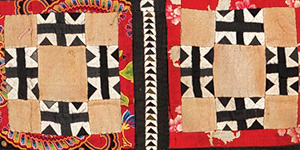
In Central Asia, death is not a remote concept. Visiting shrines, the burial sites of saints or important religious figures, continues to be an integral part of everyday life. Indeed, it is at places such as the Ismamut Ata mausoleum complex in Turkmenistan where visitors ritually tie fabrics on a wooden structure (chile agach) under which they pass with the hope that they will achieve good health, wealth or most often, fertility.
During the Soviet period, the government prohibited recitation of Muslim prayers at funerals, but because of the syncretic nature of religious practice in Central Asia, domestic rituals and folk traditions did not appear directly connected to Islam. In this way, people were able to outwardly incorporate Soviet dogma into daily life while maintaining their indigenous beliefs surrounding illness and death, some of which included the use of kurak (patchwork).
For instance, in the Karategin region of Tajikistan, a person who was ill was wrapped in kurak and at death, placed upon a mattress and cushion made of kurak. Elders recalled the burial rite of tying a small flag or handkerchief of kurak to the grave pole, but little information remains. Karmysheva wrote that the Uzbek Lakai would cut the clothing of their deceased into strips and distribute them to the community. Women collected fabric in this way, sharing remnants of cloth and festive food with family members unable to attend so they would also be blessed. According to Kyrgyz research of the 1920s, relatives and friends of the deceased often helped defray the cost of performing traditional funeral rites with donations of money and cattle. If the deceased was an adult, the donors were given gifts in response. Old men might receive money, while women received pieces of red, white, or black fabric called jyrtysh in Kyrgyz or jyrtys in Kazakh.